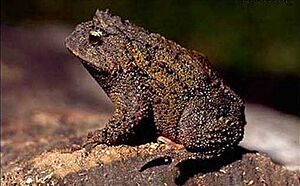Proceratophrys bigibbosa facts for kids
Quick facts for kids Proceratophrys bigibbosa |
|
|---|---|
 |
|
| Conservation status | |
| Scientific classification | |
| Synonyms | |
|
Ceratophrys bigibbosa Peters, 1872 Proceratophrys cristinae Braun, 1973 |
The Proceratophrys bigibbosa is a type of frog that belongs to the Odontophrynidae family. People also call it Peters' smooth horned frog or Cristina's smooth horned frog. You can find this frog in parts of Argentina, especially in the Misiones Province. It also lives in southern Brazil, in areas like Rio Grande do Sul and Santa Catarina. It might even live in nearby Paraguay.
Contents
What Does It Look Like?
These frogs have strong, sturdy bodies. Adult male frogs are about 36–44 mm (1.4–1.7 in) long from their snout to their rear. Female frogs are a bit bigger, measuring about 51–53 mm (2.0–2.1 in).
Face and Head Features
Their snout is short and round. They have large eyes. Behind each eye, there are two noticeable, bony bumps that look like small horns. The frog's eardrum, called the tympanum, is hard to see. A clear, curved ridge runs from their snout to their eyes.
Skin and Body
The skin on their back feels bumpy, with different sized little lumps called tubercles. Their legs are short and strong. Their fingers do not have webbing, but their toes have some webbing.
Colors and Patterns
The frog's back can be many shades of dark brown to brown. It often has dark and light stripes running along its body. A thin, curved stripe, which is whitish or tan, connects their upper eyelids. Female frogs have a black throat with red spots. Male frogs have a throat that is all black. Their belly is orange or red with black spots. The underside of their legs is black with red spots too.
Where Does It Live?
The Proceratophrys bigibbosa frog lives in Araucaria forests. These forests are found in mountains, usually between 300–1,200 m (980–3,940 ft) above sea level.
Life Cycle and Habitat
When it's not breeding season, this frog lives on land. It likes to hide in the fallen leaves on the forest floor. When it's time to breed, the frogs go to streams. They might lay their eggs under stones in the stream beds.
How Is It Doing?
The Proceratophrys bigibbosa is not a very common frog. It faces several threats that make its numbers low.
Threats to Its Home
One big problem is habitat loss. This happens when forests are cut down. People cut down trees to make space for small farms where they raise animals like cows. They also cut down forests to plant pine trees.
Other Dangers
Pollution of the soil and water also harms these frogs. Luckily, some areas where these frogs live are protected. This means their homes are safe from some of these dangers.


